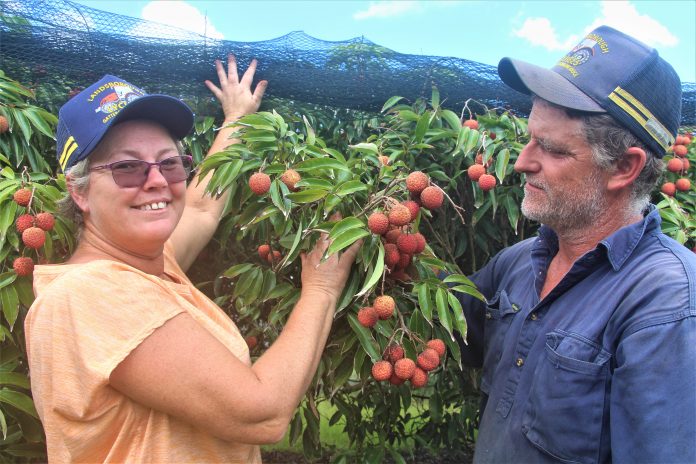A boom season for a Sunshine Coast lychee farm means juicy plans to grow the tourism side of the agricultural business are another step closer to reality.
Paul and Gynaya Gattera, of Landsborough Lychees, hope to harvest a bumper crop of 50 tonnes of fruit by the end of this week, as they draw a steady stream of buyers to their Forestry Road farm.
Customers from as far away as the Gold Coast and interstate follow the signs down Steve Irwin Way to Landsborough Lychees’ humble farm store that is open 7am-7pm seven days a week during lychee season.
Paul and Gynaya have built up strong ties with regular shoppers over the years and often will look up from the shed and wave as they arrive in the carpark, or chat briefly with them over the shop counter.
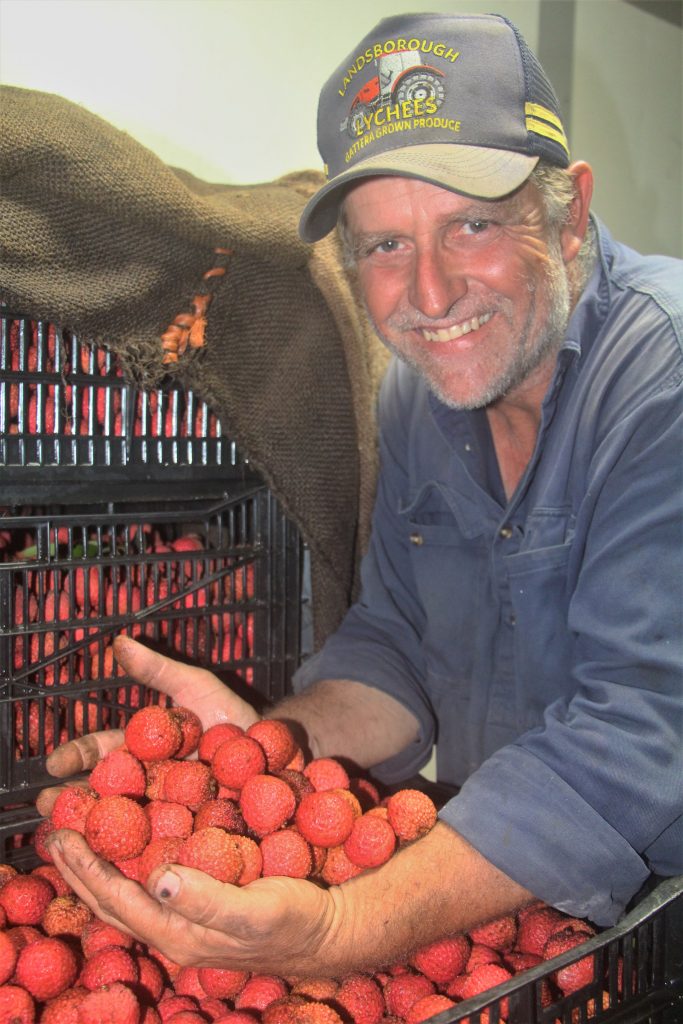
“The people that come to the farm, they just like talking to the farmer and going straight to where it’s (produce) grown,” Paul said on a lunch break in the shed, out of the mid-afternoon heat.
Those are the type of people the Gatteras hope to encourage to linger a little longer over refreshments as they soak up stunning Glass House Mountains views – part of a business expansion plan into an on-site coffee shop and larger greengrocer area.
Paul hopes that the building will be up and running in 2023, once plans have been drawn up and permits approved.
“We’ve had a builder look at it already and he’s given us a few more ideas,” he said.
Often called “the king of fruits” and a symbol of romance, the tropical species is thought to have originated in South China about 1700 BC.
Chinese gold miners introduced the fruit to Australia in the 1870s, and nearly all of the nation’s lychee production – 99% – is in Queensland.
Like stories about Sunshine Coast people doing great things? Help us deliver more by registering for our free daily news feed. All it requires is your name and email. See SUBSCRIBE at the top of this article.
The Lychee Fund Annual Report 2019/20 states that the industry doubled in value from $16.8 million in 2013/14 to be worth $34.4 million to Australian growers in 2018/19.
The most common variety grown in Australia is the Suey Tung. But Landsborough Lychees use Kwai May Pink (Bosworth 3): a small-seeded, sweet variety with a rather spiky rounded fruit in a red pink-orange hue.
Good spring rain and consistent overnight summer showers have produced a sweet bumper crop this year on the Gatteras’ 21.8ha property that has about 10ha under lychee trees.
The lychee harvest is relatively short – from around the first week of January to February 10 in southern Queensland.
And while sunburn posed a threat this year due to the recent hot and sunny days, Gynaya said they still expected “a decent year” with about 50 tonne of lychees harvested.
Paul added: “It’s getting better and better every year by a couple of tonne.”

Gynaya said their store sold “a bit of everything”, including bananas, mangoes, finger limes, feijoas, dragonfruit, zucchini, sweet potato and passionfruit – all grown on the farm.
Paul’s Italian relatives were among the town’s pioneering families and their contribution to farming and community life in the area is immortalised in Gattera Rd near Landsborough State School.
“Paul’s family has always been banana growers in the area,” Gynaya said.
“We bought the property in ’98 and we planted our first 1000 trees in the year 2000.
“We had two kids by that stage and lived at Glenview.”
Local journalists supporting local people. Help keep independent and fair Sunshine Coast news coming by subscribing to our free daily news feed. All it requires is your name and email. See SUBSCRIBE at the top of this article.
Paul knew he wanted to keep farming but needed “to find some land somewhere” while the first two of their four boys were still young.
He found the right block in 1998, cleared it a year later using their own trucks and excavators, and had a hunch about making the switch to lychees from his banana farming roots.
While he’s been able to pick the brains of other growers, virtually everything Paul now knows about lychee farming has been self-taught.
“Don’t worry. It’s been a big learning curve,” he laughed.
“We’re still learning about the different fertilisers and the different times to put them on. It makes a huge difference.
“I don’t think you’re ever going to nail it because Mother Nature will just change things at the last minute on you.
“It’s a science these days.
“We have agronomists who work for us here: they do the soil tests and the leaf analysis and they tell us what’s got to happen and when it’s got to happen.”
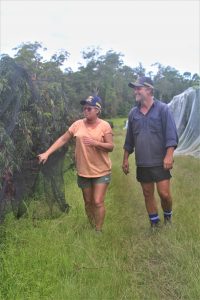
The first fruit came on the trees in 2005 when Paul admitted they were lucky to harvest a single tonne.
And 2019, the bushfires year, was also one of the worst, with the farm producing only 4 tonnes of lychees.
“We didn’t get the rainfall – just drought real bad – and the air was on fire,” Paul said.
“(Lychees need rain) any time after they finish flowering and as soon as the fruit sets.
“So, September-October you need the rain. Not a lot of rain, just consistent.
“That’s what’s making this year so good. When everything starts to dry out, we get rain overnight just to calm (the lychees) down and cool them down a bit.”
Despite the lean years, the Gatteras have had no seeds of doubt about their decision.
“We always knew we’d done the right thing,” Paul said.
“One day I knew it was going to come good.”
Gynaya will sell 12-15 tonnes of lychees through the farm store this year and the other 25-30 tonnes will mostly go to Brisbane to the Rocklea Markets, to be sold by their agent to Queensland and interstate buyers.
As the cook of the family, Gynaya had an idea about two years ago for homemade lychee ice cream using only fresh ingredients.
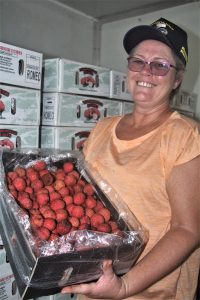
She started experimenting and her secret recipe is now a popular product sold in the store.
But the real “surprise packet” came when Gynaya expanded into freeze-dried fruit.
“That’s out next big seller here,” Paul said.
“That will probably be bigger than lychees in the future: freeze-dried mangoes, bananas and dragonfruit.
“Astronauts use it. They freeze-dry all their food when they go into space.”
The fruit lasts longer when freeze-dried in a machine like a dehydrator that keeps the all-important nutrients intact.
The sealed bags also can be left out on the kitchen bench rather than taking up space in the fridge chiller.
“I just keep selling out. I can’t keep up (with demand),” Gynaya said.
Freeze-drying fruit also means little wastage from the harvest, making the business more sustainable.
HOW TO PEEL A LYCHEE
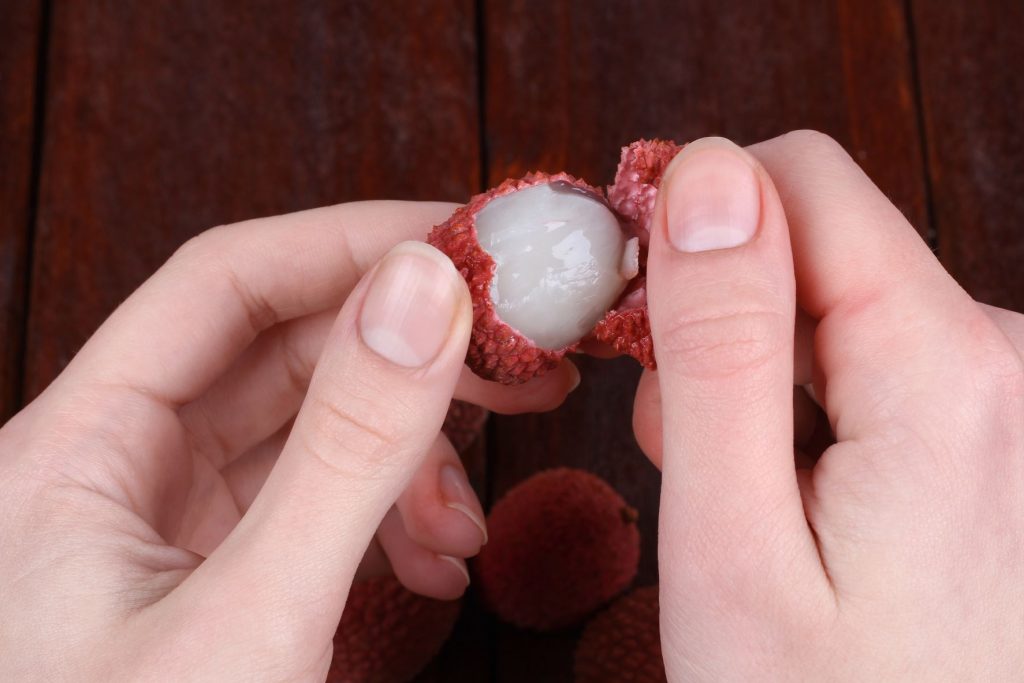
Just like peeling prawns, everyone seems to have their own way of getting into the sweet, juicy flesh of a lychee.
“Some peel with nails and some bite into it to get the peel started. Everyone does it differently,” Gynaya said.
Her tried-and-true method is to use the stem at the top to break the skin, then peel around the fruit.
But Paul begs to differ: “I haven’t got time to mess around peeling them like you do!
“If you’re standing there eating a lychee, people will say, ‘Oh what’s that?’
“You’ll give them one and they will mess around with it. They try to peel it and it just comes off in little tiny pieces.
“I just use my teeth. I bust the shoulders off them first. And then you peel it around and it will pop out in your hand.”


